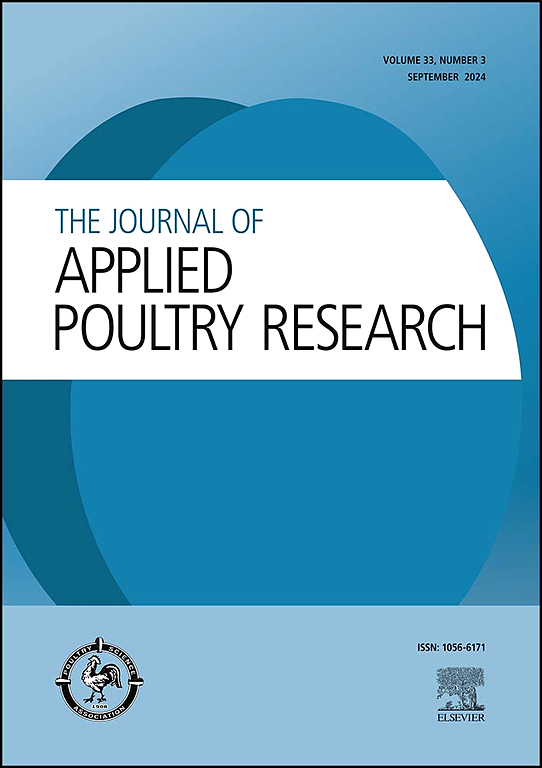The effect of hatching altitudes and broiler strains on the prevalence of ascites syndrome
IF 2
3区 农林科学
Q2 AGRICULTURE, DAIRY & ANIMAL SCIENCE
引用次数: 0
Abstract
Ascites in broilers is a metabolic disorder causing substantial economic losses in the poultry industry. This study aimed to investigate the effects of broiler strains (Ross 308 and Cobb) and hatching altitude (Rasht 0 m and Tabriz 1400 m) effects on the incidence of ascites syndrome and related traits. Two hundred forty hatching eggs of the same weight (64±1 gram) were used. The eggs hatched in both locations simultaneously. The studied parameters were incidence of ascites syndrome at 14, 21, and 42 days, lung and heart volume at 14 and 42 days, carcass performance, antioxidant status, hematological measurements, thyroid hormone levels, nitric oxide, lipid profile, uric acid, and liver enzyme level. Results showed that the strain on SOD, T3, and cholesterol, hatching altitude on lung and heart volume at 42 days, and T3, and the interaction of strain at hatching altitude on lung and heart volume at 42 days, spleen percentage, nitric oxide level, and RV-to-TV ratio were significant effect (p < 0.05). The incidence of ascites and heart volume increases with age, but lung volume decreases. Even though there is no significant difference between the two strains and the hatching altitude in most of the traits, the comparison of the numerical values of the parameters indicates that the high-altitude hatching and the Cobb strain have higher values. These data suggest that selected broiler strains and hatching environments could have a higher sensitivity to alterations in pulmonary rheological parameters at an early age, triggering the ascites syndrome.
孵化海拔和肉鸡品系对腹水综合征患病率的影响
肉鸡腹水是一种代谢紊乱,给家禽业造成了巨大的经济损失。本试验旨在探讨罗斯308和科布两种肉鸡品系和孵化海拔(拉什特0 m和大不里士1400 m)对肉鸡腹水综合征发病及相关性状的影响。用240个相同重量(64±1克)的孵化蛋。蛋在两个地方同时孵化。研究参数为14、21和42天腹水综合征发生率、14和42天肺和心脏体积、胴体性能、抗氧化状态、血液学指标、甲状腺激素水平、一氧化氮、血脂、尿酸和肝酶水平。结果表明,菌株对SOD、T3和胆固醇的影响、孵化高度对42 d肺、心脏体积和T3的影响以及孵化高度对42 d肺、心脏体积、脾脏百分比、一氧化氮水平和rv / tv比的交互作用均有显著影响(p <;0.05)。腹水发生率和心脏容积随年龄增加而增加,但肺容积减少。尽管两菌株在大部分性状上与孵化海拔没有显著差异,但数值比较表明,高海拔孵化和Cobb菌株具有更高的数值。这些数据表明,选定的肉鸡品系和孵化环境可能对早期肺流变学参数的改变具有更高的敏感性,从而引发腹水综合征。
本文章由计算机程序翻译,如有差异,请以英文原文为准。
求助全文
约1分钟内获得全文
求助全文
来源期刊

Journal of Applied Poultry Research
农林科学-奶制品与动物科学
CiteScore
4.10
自引率
10.50%
发文量
80
审稿时长
104 days
期刊介绍:
The Journal of Applied Poultry Research (JAPR) publishes original research reports, field reports, and reviews on breeding, hatching, health and disease, layer management, meat bird processing and products, meat bird management, microbiology, food safety, nutrition, environment, sanitation, welfare, and economics. As of January 2020, JAPR will become an Open Access journal with no subscription charges, meaning authors who publish here can make their research immediately, permanently, and freely accessible worldwide while retaining copyright to their work. Papers submitted for publication after October 1, 2019 will be published as Open Access papers.
The readers of JAPR are in education, extension, industry, and government, including research, teaching, administration, veterinary medicine, management, production, quality assurance, product development, and technical services. Nutritionists, breeder flock supervisors, production managers, microbiologists, laboratory personnel, food safety and sanitation managers, poultry processing managers, feed manufacturers, and egg producers use JAPR to keep up with current applied poultry research.
 求助内容:
求助内容: 应助结果提醒方式:
应助结果提醒方式:


